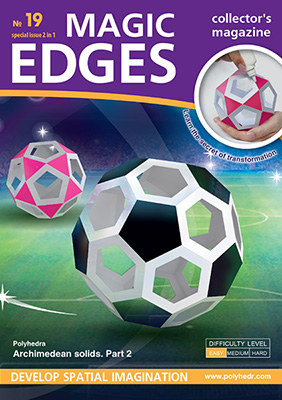

Develop spatial imagination
0.00 $
0 item(s)
Icosidodecahedron. How to make pdf template
A polyhedron is obtained by successively cutting off each of the vertices of the icosahedron or dodecahedron.
The icosidodecahedron is a semiregular convex polyhedron with two properties:
1. All faces are regular polygons of two types - a pentagon and a triangle;
2. For any pair of vertices, there is a symmetry of the polyhedron (that is, a motion that translates the polyhedron into itself) that transforms one vertex to another.
The icosidodecahedron is one of the 13 solids of Archimedes.
Archimedean solids are semiregular polyhedra in the sense that their faces are regular polygons. Still, they are not the same, while the condition of one of the types of spatial symmetry: tetrahedral, octahedral, or icosahedral is preserved.
Popular
So far, we have actively used glue to assemble polyhedrons from the Magic Edges sets. Moreover, we...
IIn issue 25 of the Magic Edges, we noticed that we get a cross-sectional cut at the cut point by...
There are coincidences, which we do not even suspect. April 12 - Cosmonautics Day!...
In the natural environment, regular polyhedra can be found in the form of crystals (minerals). The...
Make the New Year's holiday beautiful and unusual, so that the children saw in him a fairy tale,...
The festival of fascinating science was held in Moscow on April 24 and 25, 2015, at the physics...
Find a gift for the schoolboy that will be interesting, useful, and not ruin the family budget - is...










